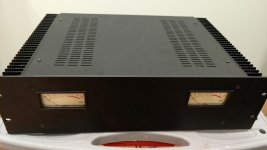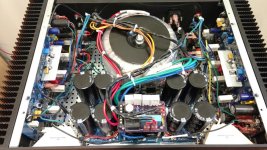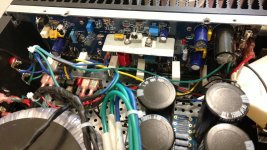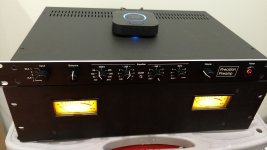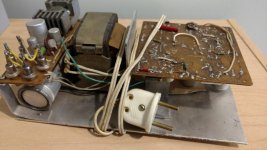Hi Ejje,
When you buy a meter for yourself, make the first one at least semi-good. Make certain that it has "true rms" for AC voltages. While you are looking, try to get one where the AC frequency response is a lot higher than 1 KHz. You may find that 100 KHz won't be that much more money.
When you are learning especially, it is important that your testing equipment doesn't "lie" to you. The cheap meters are often very, very inaccurate (ignore the fact that it has digits instead of a meter movement). It would help you to think, "it's about 40 VDC" instead of something like "it's 40.3 VDC". Often the last digit isn't even close to reality and they won't even meet the specifications printed on the box or the manual.
For an idea, very good meters are 0.03% accurate, 0.05% being common. The inexpensive meters are usually spec'd at 0.5% accurate and they are often out of tolerance even new out of the box. Other specs, like AC volts and ohms will be worse than the DC accuracy even with very good meters. The last point I have to make is that cheap meters are easily damaged where good ones can usually tolerate big mistakes. That means that as you learn, you may go through a bunch of cheap meters (and never get the right answer!).
Lastly, the mV scale is critical since that is your bias current and DC offset adjustments or checks. The inexpensive meters are often so wildly inaccurate that you might be further ahead feeling the temperature of the heat sinks, or looking at mains AC current draw with an analogue meter. I'm not suggesting that you do it this way, just trying to illustrate how useless a cheap meter can be. If you own one good meter, you can test the cheap ones and know what they errors are (transfer of calibration toa cheap meter), but when you consider AC voltages, use the good meter.
-Chris
Thanks alot for the advices, is it a big differance from 50kHz to 100kHz in performance of a meter?
I normally expect to see 63 - 64VDC with no load from a 45VAC output transformer. Voltage may be higher with poor self regulation of the transformer. Your schematic looks correct. Your next step should be to test everything in stages. Power up one transformer with bridges only connected and see what output is. Next add cap banks and check voltages again ( this should be considerably higher than transformers alone). Next connect the ground potentials between cap banks and measure again (voltage shouldn't change). Next add your loop breaker and measure again. Repeat for the second channel.
Okey I have done some more testing. And I believe I found the fault.
I followed your instructions and everything works good until i connect cap bank.
I started with only 2 capacitors connected and meanwhile I tried to start it I measured the voltage over the cap. Like before the slow start shut down very quickly. After first try I measured ~5.5VDC so then i continued pushing the start button and the caps gained about 3VDC with each push, until it reached ~26VDC.
When reaching ~26VDC it worked, voltage slowly rised to 60VDC and I got a nice negative volt reading on the other cap(just as it was supposed to be)
So, probably the wiring was right all along but the slow start can't handle the inrush current? Even with only 2 caps with is 20kuF each. I know this still is quite a lot of capacitance but shouldn't a slow start designed for amplifiers be able to handle 40kuF at 60V?
I did some research about the slow start wich I picked up from ebay and I found out that it has 4 NTC resistors but 2 of them is wired in parallel.
Link to diyAudio thread and post showing schematic of NTC setup
I understand it probably was a bad choice of slow start/trying to save a few bucks. Do you guys think its possible to mod the NTC setup to handle my cap bank? In the forum thread mentioned above it says that the NTCs are the type: "10D-11". From what i found online one of these can only handle 3A max.
I got some CL-60 at home , rated for 5A, could the be a better replacement maybe?
Best regards
Ejje
Protection and control circuits are something you shouldn't go cheap on in an amplifier, much like brakes and seat belts in your car. These systems protect you and your speakers. That softstart design is terrible, NTCs cannot be used in parallel. The power relay and bypass relay in series is also not ideal, they should be in parallel to minimize unneeded connections in the main power circuit.
Vzaichenko and I have put together some excellent complete protection systems that have been thoroughly tested and are very reliable. We have multiple configurations in through hole and SMT designs to suit almost any amplifier you can dream up. When using separate main power transformers we start each transformer at different times, each on it's own soft start circuit to minimize line drop. The power supply is also automatically shut off instantly if there is any problems in the amplifier itself. This saves a lot of parts and burnt part smell in the event of amplifier failure. How to build a 21st century protection board
Vzaichenko and I have put together some excellent complete protection systems that have been thoroughly tested and are very reliable. We have multiple configurations in through hole and SMT designs to suit almost any amplifier you can dream up. When using separate main power transformers we start each transformer at different times, each on it's own soft start circuit to minimize line drop. The power supply is also automatically shut off instantly if there is any problems in the amplifier itself. This saves a lot of parts and burnt part smell in the event of amplifier failure. How to build a 21st century protection board
Last edited:
Hi Ejje,
You are going to own and use this meter for decades as long as it lasts. The Keysight and Fluke meters will do this for you - and keep their calibration on top of that. That means that they will stay in tolerance. In deciding, try each meter out as you may find one is easier for you to figure out than the other. Between good meters, use the one you don't have to fight with.
If you go with a bench meter (more expensive, more accurate, more reliable), consider the Keysight brand again, and the Kiethley brand. Keysight makes equipment that tends to become industry standards. Kiethley makes excellent specialty meters. Again, try them before deciding as you're going to have these for a long, long time.
Keysight used to be Agilent and before that, HP. Most of my equipment is HP/Agilent/Keysight. Older Tektronix oscilloscopes are good (analogue ones), but so are the old HP 'scopes. The current 'scopes from Keysight are excellent, and Rigol makes a very good digital oscilloscope as well. I'd be wrong not to mention LeCroy and Rohde & Schwarz. Most value priced equipment isn't very good over the long haul, and that is what you need. Tektronix is trying to make a comeback as well.
-Chris
I think it depends on the brand. The best meters in hand held are Keysight and Fluke. Extech has big claims, but doesn't hold calibration well. There is a massive difference between the two top brands and the rest. If you are comparing models in a line, then there isn't much difference between 50 KHz and 100 KHz. A 50 KHz rating on a cheap meter isn't something I would trust.is it a big differance from 50kHz to 100kHz in performance of a meter?
You are going to own and use this meter for decades as long as it lasts. The Keysight and Fluke meters will do this for you - and keep their calibration on top of that. That means that they will stay in tolerance. In deciding, try each meter out as you may find one is easier for you to figure out than the other. Between good meters, use the one you don't have to fight with.
If you go with a bench meter (more expensive, more accurate, more reliable), consider the Keysight brand again, and the Kiethley brand. Keysight makes equipment that tends to become industry standards. Kiethley makes excellent specialty meters. Again, try them before deciding as you're going to have these for a long, long time.
Keysight used to be Agilent and before that, HP. Most of my equipment is HP/Agilent/Keysight. Older Tektronix oscilloscopes are good (analogue ones), but so are the old HP 'scopes. The current 'scopes from Keysight are excellent, and Rigol makes a very good digital oscilloscope as well. I'd be wrong not to mention LeCroy and Rohde & Schwarz. Most value priced equipment isn't very good over the long haul, and that is what you need. Tektronix is trying to make a comeback as well.
-Chris
Protection and control circuits are something you shouldn't go cheap on in an amplifier, much like brakes and seat belts in your car. These systems protect you and your speakers. That softstart design is terrible, NTCs cannot be used in parallel. The power relay and bypass relay in series is also not ideal, they should be in parallel to minimize unneeded connections in the main power circuit.
Vzaichenko and I have put together some excellent complete protection systems that have been thoroughly tested and are very reliable. We have multiple configurations in through hole and SMT designs to suit almost any amplifier you can dream up. When using separate main power transformers we start each transformer at different times, each on it's own soft start circuit to minimize line drop. The power supply is also automatically shut off instantly if there is any problems in the amplifier itself. This saves a lot of parts and burnt part smell in the event of amplifier failure. How to build a 21st century protection board
Yeah you're right, it was a bad choice. But isn't it a bit strange that it's not working at all with only two of my capacitors? I checked my NTCs and they are the type: "20D-20", not "10D-11" as I thought before.
I understand why the parallel setup of the NTCs is bad but at least the two 20D-20 NTCs in series should be "active" during start sequence? Would it work better if I modded it so all the NTCs was in series instead?
I would really like to understand why my modules are not working, mostly for the sake of learning
The 21st century protection board seems really nice. I will try to do more reading about it, you guys have a lot of different versions
Hi Ejje,
I think it depends on the brand. The best meters in hand held are Keysight and Fluke. Extech has big claims, but doesn't hold calibration well. There is a massive difference between the two top brands and the rest. If you are comparing models in a line, then there isn't much difference between 50 KHz and 100 KHz. A 50 KHz rating on a cheap meter isn't something I would trust.
You are going to own and use this meter for decades as long as it lasts. The Keysight and Fluke meters will do this for you - and keep their calibration on top of that. That means that they will stay in tolerance. In deciding, try each meter out as you may find one is easier for you to figure out than the other. Between good meters, use the one you don't have to fight with.
If you go with a bench meter (more expensive, more accurate, more reliable), consider the Keysight brand again, and the Kiethley brand. Keysight makes equipment that tends to become industry standards. Kiethley makes excellent specialty meters. Again, try them before deciding as you're going to have these for a long, long time.
Keysight used to be Agilent and before that, HP. Most of my equipment is HP/Agilent/Keysight. Older Tektronix oscilloscopes are good (analogue ones), but so are the old HP 'scopes. The current 'scopes from Keysight are excellent, and Rigol makes a very good digital oscilloscope as well. I'd be wrong not to mention LeCroy and Rohde & Schwarz. Most value priced equipment isn't very good over the long haul, and that is what you need. Tektronix is trying to make a comeback as well.
-Chris
Thanks for the explanation, the Fluke 115 seems nice for ~200Euro here in Sweden. With 50kH and +/- (0,5%) accuracy on DC reading from what i understand. Right now my student budget is tight due to all the unforeseen expenses on the Honey Badger but I will absolutely be on the lookout for a higher grade meter when I'm able to buy one
Hi Ejje,
I think you are making a good decision with the Fluke. It will serve you very well. It will also hold it's calibration well.
Just for chuckles and grins when you have some time and a calculator, work out the error budget for your Fluke for a resistor of some mid value (10's of Kohms), do the same for AC and DC voltages (DC in mV and a few hundred V), same for the AC voltage range. Does this one have a "true RMS" type AC response? I can't remember.
An "error budget" for the meter will look something like:
(Basic accuracy) + (% of error for range) + (one or more least significant digits) = Total uncertainty.
There may be other terms, and there is a consideration for how long since the last calibration was. This will be very instructive so you know how much the actual value might be from the indicated value. This means that your reading might be xx.x mV, and the actual value might be anywhere so that your answer can only be stated as xx mV +/- 2.5 mV (say for example). That means that the reading of 15.3 mV could really be anywhere from 12.8 mV to 17.8 mV. Some meters are worse than this, but my point is that when you read a value off the display, would it be proper to say 15.3 mV, or "about 15 mV"? This is what the world of Metrology is all about. But you should have an understanding of just what that meter reading really is. In the old days, an analogue meter would be 2% ~ 3.5% of full scale on that range and people knew to read it like "its about 15 mV" instead of reading to the fractions of a division. Some of the first digital meters were less accurate than an analogue meter! But, people like numbers. It takes practice to accept that the number you read off the scale is approximate. Some meters more approximate than others.
Understand your tools and they won't surprise you.
-Chris
I think you are making a good decision with the Fluke. It will serve you very well. It will also hold it's calibration well.
Just for chuckles and grins when you have some time and a calculator, work out the error budget for your Fluke for a resistor of some mid value (10's of Kohms), do the same for AC and DC voltages (DC in mV and a few hundred V), same for the AC voltage range. Does this one have a "true RMS" type AC response? I can't remember.
An "error budget" for the meter will look something like:
(Basic accuracy) + (% of error for range) + (one or more least significant digits) = Total uncertainty.
There may be other terms, and there is a consideration for how long since the last calibration was. This will be very instructive so you know how much the actual value might be from the indicated value. This means that your reading might be xx.x mV, and the actual value might be anywhere so that your answer can only be stated as xx mV +/- 2.5 mV (say for example). That means that the reading of 15.3 mV could really be anywhere from 12.8 mV to 17.8 mV. Some meters are worse than this, but my point is that when you read a value off the display, would it be proper to say 15.3 mV, or "about 15 mV"? This is what the world of Metrology is all about. But you should have an understanding of just what that meter reading really is. In the old days, an analogue meter would be 2% ~ 3.5% of full scale on that range and people knew to read it like "its about 15 mV" instead of reading to the fractions of a division. Some of the first digital meters were less accurate than an analogue meter! But, people like numbers. It takes practice to accept that the number you read off the scale is approximate. Some meters more approximate than others.
Understand your tools and they won't surprise you.
-Chris
A single good quality 5 amp NTC per transformer should work fine for you. 40R would be good for 240VAC mains. Your supplies should be charged in 4 or 5 seconds.
Hi again,
I did some mods on the soft start. I rewired the NTC so be in series and doubled the capacitance on the rc network to the 555-timer circuit, so NTC relay delay became 2 seconds instead of 1.
It did not help at all. I just shuts down as soon as i turn it on with capacitors connected. I guess i have to find a new solution...
Could you send me a PM with what config of the 21st century protection board that would be suitable for a dual mono setup like mine? I don't really understand the different choices displayed on your website and in the forum thread there is talk of a brand new version as i understand?
The website is pretty outdated. It's easiest just to contact us through the website and we make suggestions what combination of parts will work best for your application. virtualzeroaudio@gmail.com
The website is pretty outdated. It's easiest just to contact us through the website and we make suggestions what combination of parts will work best for your application. virtualzeroaudio@gmail.com
Alright, I'll sent you an email describing my build right away
Hi,
I wish to to the Honeybadger as my next project.
Can some one direct me to the latest schematic Ver 2.4.
Thanks and regards,
Sumesh
Take a look at the Wiki.
Honey Badger and Doug Self Preamp
These past 3 months have been a blast! I have had a lot of fun building Honey Badger and Doug Self Preamp. I have learned a lot and keep learning. Working on this project has also been a way for me to re-live my school years. The last picture is of the 4 Watt stereo amplifier I built in my 11th grade.
Thank you everyone who have been answering my (sometime stupid) questions. I couldn't have done it without you! Thank you to DiyAudio staff and moderators for maintaining the forums and the store.
I hope to be able to start contributing back some day, maybe when I am done with all of the 1192 pages of The Art of Electronics by Horowitz Hill?
These past 3 months have been a blast! I have had a lot of fun building Honey Badger and Doug Self Preamp. I have learned a lot and keep learning. Working on this project has also been a way for me to re-live my school years. The last picture is of the 4 Watt stereo amplifier I built in my 11th grade.
Thank you everyone who have been answering my (sometime stupid) questions. I couldn't have done it without you! Thank you to DiyAudio staff and moderators for maintaining the forums and the store.
I hope to be able to start contributing back some day, maybe when I am done with all of the 1192 pages of The Art of Electronics by Horowitz Hill?
Attachments
Hi Joanito,
As low as you can reasonably get, and as long as it sounds good. It is possible to make something with very low THD that doesn't sound good. The reverse is also true, you just think it sounds good, but after some time listening the truth comes out.
For solid state, probably 0.05% might be reasonable.
-Chris
As low as you can reasonably get, and as long as it sounds good. It is possible to make something with very low THD that doesn't sound good. The reverse is also true, you just think it sounds good, but after some time listening the truth comes out.
For solid state, probably 0.05% might be reasonable.
-Chris
Hi anatech,
The Honey Badger is, not only, but also, build under the technics of Bob Cordell , right ?... so i expected something like thd < 0.001 . I sayed "I know it's not easy to say" in previous post because per example: mesure in LTSpice is one thing, mesure in real life is another, etc , it's hard to say an exact value...
The value of distortion of the Honey Badger is very very low, isn't it ? Around 0.001% perhaps...
Thanks guys
The Honey Badger is, not only, but also, build under the technics of Bob Cordell , right ?... so i expected something like thd < 0.001 . I sayed "I know it's not easy to say" in previous post because per example: mesure in LTSpice is one thing, mesure in real life is another, etc , it's hard to say an exact value...
The value of distortion of the Honey Badger is very very low, isn't it ? Around 0.001% perhaps...
Thanks guys
- Home
- Amplifiers
- Solid State
- diyAB Amp The "Honey Badger" build thread
